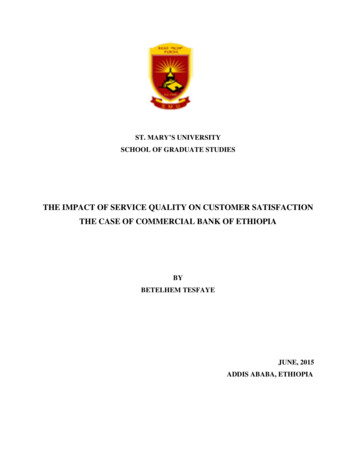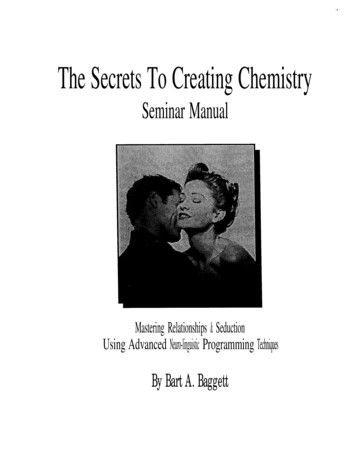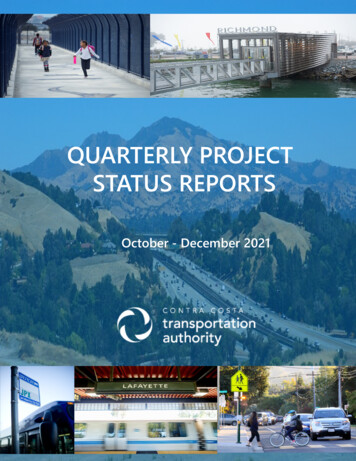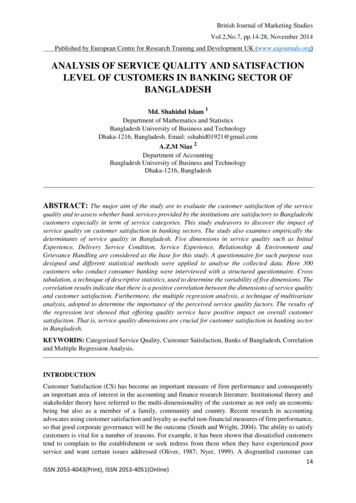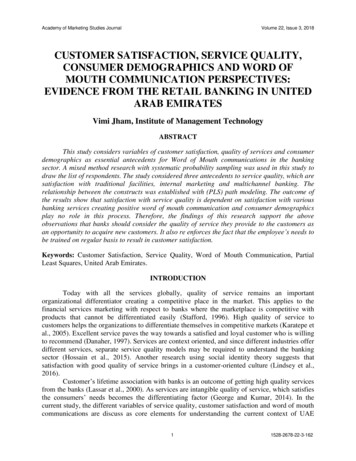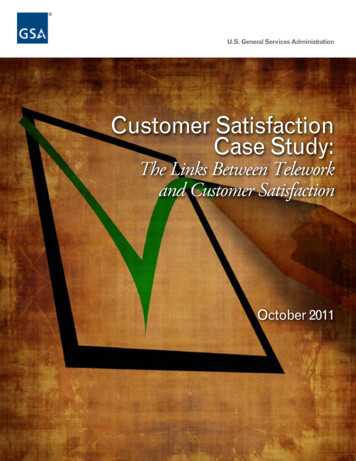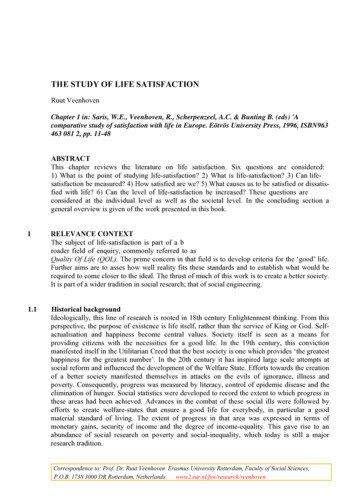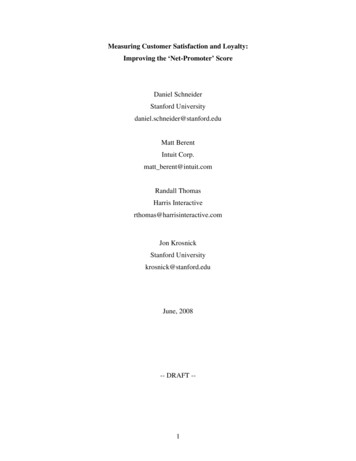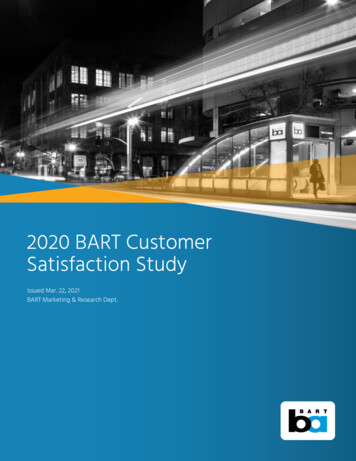
Transcription
2020 BART CustomerSatisfaction StudyIssued Mar. 22, 2021BART Marketing & Research Dept.
This page intentionally left blank.
2020 BART CUSTOMER SATISFACTION STUDYCONTENTSINTRODUCTION. 2EXECUTIVE SUMMARY . 4DETAILED RESULTS . 8Overall Satisfaction .9Willingness to Recommend BART .11Perception of Value .13Specific Service Attributes .15Quadrant Analysis .19Ethnicity Compared to Region .23APPENDICESA. Questionnaire.24B. Complete Tabulations .31C. Service Attribute Ratings – Percentages .58D. Description of Methodology .60E. Coding of Respondent Comments.68F. 2018 Quadrant Chart .71BART Marketing and Research Department1
2020 BART CUSTOMER SATISFACTION STUDYINTRODUCTIONBART’s Customer Satisfaction Study is a tool to help BART prioritize efforts to achieve higher levels ofcustomer satisfaction. The study involves surveying BART customers onboard randomly selected traincars every two years to determine how well BART is meeting customers’ needs and expectations. Thesesurveys, initiated in 1996, are conducted by an independent research firm.This report presents the results of BART’s 13th Customer Satisfaction Study, conducted in October 2020.Conditions at the time of the survey were very different from any past survey that BART has conducteddue to the COVID-19 pandemic. Bay Area residents were being encouraged to avoid non-essential travel,and many employers were allowing employees to work from home if feasible. For those making essentialtrips, wearing face coverings and social distancing were required in order to control the spread of thevirus. BART ridership was at 12% of typical levels, with average weekday ridership of 53,300 in October2020, as compared to approximately 433,000 at the time of the last survey in September 2018.Operationally, BART implemented many changes due to the pandemic. Due to lower ridership, servicehours and frequency were reduced. However, BART continued to run long trains despite the dramaticdrop in ridership in order to facilitate social distancing onboard. BART implemented numerous otherinitiatives to provide riders with a safe and clean environment including: Fogging train cars with disinfectant every 24 hours;Disinfecting touchpoints inside trains at end-of-line stations;Disinfecting touchpoints inside stations and elevators several times a day;Installing hand sanitizer dispensers at all stations;Installing signage communicating face covering requirements at all station entrances;Providing masks to those who needed them (via Station Agents, BART Police, and ambassadors).Since it was clear that this would not be a typical Customer Satisfaction Survey, postponing the surveywas considered. However, it may be quite a while until BART ridership returns to “normal,” and BARTrelies on customer data to evaluate how well it’s doing and to inform the prioritization of potential newinitiatives. Additionally, proceeding with the survey would enable BART to get feedback on its COVID-related initiatives and learn more about its current riders, including their trip purposes and demographics.Conducting an onboard survey during a pandemic required some additional precautions and some slightchanges to the methodology. Survey staff were required to wear masks and maintain as much distanceas possible from others on the train. They were advised to not approach any passenger who was notwearing a face covering. Flexible questionnaire return options were available to riders – in addition tocompleting the paper questionnaire onboard, riders could choose to instead fold and mail it back later(postage-paid), take the survey online using the URL or QR code printed on the questionnaire, or scan a2BART Marketing and Research Department
2020 BART CUSTOMER SATISFACTION STUDYQR code on a clipboard if they preferred a contactless option. (Additional details about methodologicalchanges are in Appendix D.)Note that due to the very different context in which this survey was conducted, as well as other factors(changes in ridership – both in terms of number of riders and demographic composition – and minorchanges to survey methodology), it is not advisable to directly track satisfaction-related questions andattribute ratings against prior surveys. However, key statistics from the 2018 survey are noted whererelevant throughout this report for reference.The 2020 survey was conducted over a two-week period in October, including both weekdays andweekends, and resulted in 2,969 completed questionnaires. (For reference, 5,294 questionnaires werecompleted in 2018.)The Executive Summary in the next section highlights key findings from the survey. Subsequent sectionspresent detailed analyses of the factors that influence customer satisfaction and a description of thesurvey methodology, including a copy of the questionnaire.The initial survey questions ask customers about the trip they are making when intercepted (entrystation, trip purpose, etc.). Customers are then asked three key opinion questions focusing on: Overall satisfaction;Willingness to recommend BART; andPerceptions of BART’s value for the money.In addition, the survey probes for ratings of 22 specific service attributes, ranging from on-timeperformance to station cleanliness. BART uses the service attribute ratings to set priorities for customersatisfaction initiatives.It should be noted that a number of changes have occurred since the previous study in fall of 2018,including the following: The COVID-19 pandemic which dramatically altered people’s daily lives and reduced BART’sridership, starting with the first Bay Area “shelter-in-place” order on March 17, 2020 Regional homelessness and opioid crises, exacerbated by the pandemicThe opening of two new BART stations, Milpitas and Berryessa / North San José, in June 2020More Fleet of the Future trains in service (17 were in service in 2020, as compared to only oneduring the 2018 survey) New discounted fares for eligible low-income riders through MTC’s Clipper Start program (20%discount) Ambassador program to increase the presence of uniformed personnel on trains, which waslaunched as a pilot program in February 2020 and made permanent in October 2020.BART Marketing and Research Department3
2020 BART CUSTOMER SATISFACTION STUDYEXECUTIVE SUMMARYOverall, riders gave BART relatively high ratings on the three key satisfaction questions. While prior years’satisfaction data are not shown graphically in the charts in this report due to the very different contextfor this year’s survey, key results from the last two surveys are noted in the text for reference. 72% say they are very or somewhat satisfied with BART. This is up 16 percentage points from56% in 2018. 81% would definitely or probably recommend BART to a friend or out-of-town guest. This is upeight percentage points from 74% in 2018. 66% agree strongly or somewhat that “BART is a good value for the money.” This is up 11percentage points from 55% in 2018.Given the different context for this year’s survey, as well as the changes in ridership (both in terms ofnumber of riders and demographic composition), it is difficult to pinpoint precise reasons for therelatively strong ratings, at least compared to the last two surveys. However, the survey data and openended comments point to the following factors: A review of open-ended comments revealed that many riders were grateful and relieved thatBART was still running during the pandemic, providing reliable and much needed service, despiteall the uncertainty in other aspects of current life. The quadrant chart (see page 19) revealed that COVID-related attributes were of high importanceto riders, and BART was rated above average on all of these (BART’s COVID-related responseefforts, ability to social distance on the BART system, and face covering compliance). BARTimplemented many COVID-related initiatives, including fogging trains with disinfectant every 24hours, more frequent disinfecting of touchpoints within stations and on trains, providing handsanitizer dispensers at all stations, running ten-car trains as much as possible to facilitate socialdistancing, and installing signage to remind riders that face coverings are required. On-time performance, also of high importance to riders, was the highest-rated attribute in thisyear’s survey. In past surveys, crowded trains contributed to lower satisfaction scores. With BART ridership at12% of typical levels due to the pandemic, and with long trains being maintained to allow forsocial distancing, most riders were able to have sufficient space on trains. It is also noteworthythat those who were able to social distance for their entire BART ride were much more likely to besatisfied with BART than those who were not able to do so.Demographic differences could also have impacted results. Compared to 2018 riders, current riders are4BART Marketing and Research Department
2020 BART CUSTOMER SATISFACTION STUDYmore likely to have lower household incomes, to not have a car, and to identify as non-white.Additionally, riders ages 55 comprised a higher percentage of riders than in 2018. In this survey and inpast years’ surveys, older riders have tended to rate BART more positively than younger riders. (Note thatin a few past surveys, riders with lower incomes also tended to rate BART more positively than those withhigher incomes. However, there did not appear to be a strong correlation between income andsatisfaction in this year’s survey.)In terms of where BART should focus its efforts to improve customer satisfaction, the quadrant chartprioritization exercise showed that the target issues of cleanliness, particularly train cleanliness, andpersonal security were of high importance, but were rated below average by customers. The lowestrated attribute, addressing homelessness on the BART system, was also of above-average importance tocustomers and is often inter-related with cleanliness and personal security, based on open-endedcomments. If BART is able to invest in improvements in these areas, customer satisfaction is likely toincrease.With regard to train interior cleanliness, riders commented on dirty and/or damaged seats, specificallyon legacy cars, as well as food and trash left on trains. Some expressed a desire for trains to be cleanedmore frequently throughout the day, with a few noting that they expected cleaner trains due to thepandemic. The comments about station cleanliness were typically more general, with a few noting thatcleanliness varied by station, calling out specific stations they felt needed more attention (such asdowntown San Francisco stations).Ratings of these cleanliness attributes were likely impacted by changes to cleaning protocolsnecessitated by the COVID-19 pandemic. Many employees responsible for cleaning trains and stationshave been redeployed to duties focusing on disinfection.Twenty-seven percent of active “Utility Workers” (responsible for cleaning trains, performing preventivemaintenance on train cars in shops, and maintaining shops and transportation facilities) were re-deployedto COVID-related cleaning, such as nightly disinfecting of the fleet, end-of-line disinfecting of hightouchpoints on train cars, and deep cleaning of facilities with positive COVID cases. While these changeswere necessary due to the pandemic, there are currently fewer staff available to pick up food andgarbage left on trains at ends of lines and to respond to biohazard issues while the trains are in service.Similarly, duties for many “System Service Workers” (responsible for cleaning stations and employeefacilities) have changed to emphasize disinfection. Twelve of 127 active System Service Workers werepulled from their normal duties to form a new team tasked with disinfecting high touchpoints at highBART Marketing and Research Department5
2020 BART CUSTOMER SATISFACTION STUDYvolume stations. Overall, a substantial amount of resources has been redirected from standard stationcleaning / trash removal duties to disinfection. For example, 25% of all System Service Worker hours arecurrently spent on disinfection.Increasing train and station cleaning, while maintaining current disinfecting protocols, would require asubstantial increase in funding.Comments about personal security referenced the need for more police, the presence of homeless riders,individuals not wearing masks, fare evasion, drug use / smoking on BART, and disruptive passengers.Some specifically mentioned that riding BART at night was a concern.Looking at data from the BART Police Department from 2020, the most common type of call was for“well-being and medical assistance.” This supports the Police Department’s recent initiative to launch itsProgressive Policing and Community Engagement Bureau, which includes “non-sworn” unarmedpersonnel, such as the Transit Ambassadors. The Transit Ambassador program, consisting of 10 unarmed,uniformed personnel trained in de-escalation, was launched as a pilot program in February 2020 and madepermanent in October 2020. By summer 2021, BART Police plans to hire 20 Crisis Intervention Specialists tojoin the Bureau. These employees, who will be trained to handle mental health emergencies and homelessoutreach, will serve as case managers, communicating with county and non-profit agencies as needed.BART will also be deploying additional officers dedicated to patrolling trains during swing shift (latemorning through evening), starting in late March 2021. (This is in addition to the “Train Teams” currentlyworking earlier hours.)If riders have a non-emergency situation to report, they are now able to text the BART Police to reportthe issue. The text line was launched in August 2020 to provide riders with another discreet means ofnotifying BART Police of an issue, in addition to the BART Watch app.With regard to addressing homelessness, this is an incredibly complex issue that requires a coordinatedregional response. While the issue is not unique to BART, it has a big impact on the system, and BART hasalready developed successful outreach programs in partnership with San Francisco and Contra Costacounties. As the pandemic has exacerbated the Bay Area homelessness crisis due to the accompanyingeconomic downturn, along with housing instability and shelter closures, it is not surprising that manycontinue to seek shelter on BART property. In response, BART is participating in the newly formedRegional Impact Council (RIC), which consists of leaders across various Bay Area sectors, to develop6BART Marketing and Research Department
2020 BART CUSTOMER SATISFACTION STUDYcoordinated strategies to address the unsheltered homeless crisis. BART has also created a new position,“Senior Manager of Social Services Partnerships” to implement a Strategic Homeless Action Plan for BART.The plan will involve public/private partnerships, advocacy at all levels of government, and collecting andtracking key metrics to evaluate the success of the plan. Additionally, addressing homelessness will be aprimary focus of the new Crisis Intervention Specialists (part of the BART Police Department’s ProgressivePolicing and Community Engagement Bureau, as mentioned above).BART Marketing and Research Department7
2020 BART CUSTOMER SATISFACTION STUDYDETAILEDRESULTS8BART Marketing and Research Department
2020 BART CUSTOMER SATISFACTION STUDYOVERALL SATISFACTIONOverall, 72% of BART riders are very or somewhat satisfied with BART. For reference, this is substantiallyhigher than satisfaction ratings in the 2018 survey, and somewhat higher than ratings in the 2016 survey.(In 2018, 56% were very or somewhat satisfied, and in 2016, 69% were very or somewhat satisfied. Thusfar, the highest rating was achieved in 2004, when 87% of customers were satisfied with BART.)*Overall, how satisfied are you with the services provided by BART?39%34%2020: 72% satisfied; 9% dissatisfied2018: 56% satisfied; 21% dissatisfied18%7%3%Very SatisfiedSomewhat SatisfiedNeutralSomewhatDissatisfiedVery Dissatisfiedn: 2,959Note that Top 2 Box score of 72% and Bottom 2 Box score of 9% are impacted by rounding.*In this year’s report, missing responses have been excluded from the percentages, which differs from prior years’ reports. As such, thesatisfaction percentage for 2004 was previously reported as 86%.BART Marketing and Research Department9
2020 BART CUSTOMER SATISFACTION STUDYOVERALL SATISFACTION(Peak / Off-Peak / Weekend Comparison)As in past years’ surveys, there are some differences among customers who ride at during different timeperiods, most notably that weekend riders are more likely to be “very satisfied” than weekday peak riders.Overall, how satisfied are you with the services provided by BART?42%Total44%Weekday Peak39%Weekday Offpeak37%34%Weekend34%32%29%18% 19%19%17%7%7%7%5%3%Very SatisfiedSomewhat SatisfiedNeutralSomewhatDissatisfied3%2%3%Very DissatisfiedTotal n: 2,959Peak n: 972Off-peak n: 1,215Weekend n: 77210BART Marketing and Research Department
2020 BART CUSTOMER SATISFACTION STUDYWILLINGNESS TO RECOMMEND BARTAbout eight out of ten riders (81%) would recommend BART. This is up from 74% in the 2018 survey.Would you recommend using BART to a friend or out-of-town guest?53%2020: 81% would recommend; 6% would not2018: 74% would recommend; 9% would not29%13%4%DefinitelyProbablyMight or Might NotProbably Not2%Definitely Notn: 2,952Note that Top 2 Box score of 81% is impacted by rounding.BART Marketing and Research Department11
2020 BART CUSTOMER SATISFACTION STUDYWILLINGNESS TO RECOMMEND BART(Peak / Off-Peak / Weekend Comparison)Weekend riders are more likely to “definitely recommend BART” than weekday riders.Would you recommend using BART to a friend or out-of-town guest?Total59%Weekday Peak54%53%Weekday Off-Peak49%Weekend29% 30% 29%26%13%15%12%10%4%DefinitelyProbablyMight or Might Not5%3%3%Probably Not2%2%2%2%Definitely NotTotal n: 2,952Peak n: 969Off-peak n: 1,210Weekend n: 77312BART Marketing and Research Department
2020 BART CUSTOMER SATISFACTION STUDYPERCEPTION OF BART AS GOOD VALUEAbout two out of three (66%) see BART as a good value. This is up 11 percentage points from 55% in 2018.To what extent do you agree with the following statement:"BART is a good value for the money."35%31%2020: 66% agree; 14% disagree2018: 55% agree; 23% disagree20%9%5%Agree stronglyAgree somewhatNeutralDisagree somewhatDisagree stronglyn: 2,920BART Marketing and Research Department13
2020 BART CUSTOMER SATISFACTION STUDYPERCEPTION OF BART AS GOOD VALUE(Peak / Off-Peak / Weekend Comparison)Weekday off-peak and weekend customers are more likely to agree strongly that BART is a good value, ascompared to weekday peak customers.Peak period customers are more likely to ride BART five or more days per week, so the aggregate faresthey pay exceed fares paid by off-peak and weekend customers. While off-peak and weekend customersgenerally ride BART less frequently, they are a much larger group of people overall and are an importantpart of public support for the BART system.38% 38%To what extent do you agree with the following statement:"BART is a good value for the money."35%32%31% 31%Total32%Weekday Peak29%Weekday Off-PeakWeekend21%20%20%18%9%10%8%9%5%Agree StronglyAgree SomewhatNeutralDisagree Somewhat6%4%5%Disagree StronglyTotal n: 2,920Peak n: 963Off-peak n: 1,192Weekend n: 76514BART Marketing and Research Department
2020 BART CUSTOMER SATISFACTION STUDYSPECIFIC SERVICE ATTRIBUTESIn the 2020 survey, customers rated BART on 22 specific service attributes. (Note that the number ofattributes was greatly reduced from 46 in 2018 in order to streamline the questionnaire, making it fasterand easier for riders to complete, as well as to allow space for a postage-paid mail-back panel on thequestionnaire.)These attributes included four new items and one modified item.New attributes on the 2020 survey BART (official) mobile appAbility to social distance (stay 3 to 6 feet away from others) on the BART systemBART’s COVID-related response effortsCompliance with face covering policy on the BART systemModified attribute Presence of BART Police (The 2018 survey included three police-related attributes: Presence ofBART Police on trains, Presence of BART Police in stations, and Presence of BART Police outsidestations)The chart on page 18 shows mean ratings for each of these 22 service attributes. Items appearing towardsthe top of the chart are rated highest, while items appearing at the bottom are rated lowest. The averagerating (on a scale from 1 Poor to 7 Excellent) is shown next to the bar for each item.BART received the highest ratings for: On-time performance of trainsThe bart.gov websiteAccess for people with disabilitiesBART received the lowest ratings for: Addressing homelessness on the BART systemEnforcement against fare evasionPresence of BART PoliceLooking at BART’s internal tracking data for on-time performance (reported in BART’s “QuarterlyPerformance Reports”), the “Customers On Time” metric was up nearly one percentage point vs. thesurvey period in 2018 (94.4% vs. 93.6%). On-time performance has historically been correlated with highlevels of customer satisfaction, so BART’s strong performance here likely contributed to the relativelystrong customer satisfaction ratings this year.BART Marketing and Research Department15
2020 BART CUSTOMER SATISFACTION STUDYThe lowest rated attribute, “Addressing homelessness on the BART system,” was also the lowest-ratedattribute in 2018. Among those who provided comments about this issue, many also mentioned issues ofcleanliness, drug use, fare evasion, personal security, and some riders who appeared to be homeless notwearing face coverings. While most commenters felt that the number of homeless riders on BART was anissue, specifically those causing disturbances, some noted that they did not want to see aggressivemeans being used to address homelessness. As this attribute is also a “target issue,” it is discussed furtherin the Quadrant Analysis section of this report.With regard to enforcement against fare evasion, BART began testing a new style of fare gate at theRichmond station in June 2020. These fare gates use swing style barriers that discourage users frompushing through, jumping over, or maneuvering under the gates. While the estimated 90 million projectto replace fare gates system wide is not yet fully funded, it is expected to greatly reduce fare evasiononce implemented.Regarding “Presence of BART Police,” among those who provided open-ended comments, most wantedto see increased police presence / security on BART, specifically onboard trains and especially at night.The specific issues that commenters mentioned were crime and disturbances on BART, specifically in theevening, homelessness, fare evasion, and drug use.Starting in late March 2021, the BART Police Department will be adding officers dedicated to patrollingtrains during swing shift (late morning through evening). This swing shift “Train Team” consisting of fourofficers and a sergeant will join the existing early dayshift team (nine officers and a sergeant) in increasingpolice presence on trains, along with the Critical Asset Protection (CAP) team officers, Fare InspectionOfficers (FIOs), Community Service Officers (CSOs), and Ambassadors.For issues that don’t necessarily require a sworn officer, such as addressing homelessness on BART, theBART Police Department has launched a new Bureau, the Progressive Policing and CommunityEngagement Bureau. The BART Police Department is currently in the process of hiring 20 CrisisIntervention Specialists, who will focus on connecting those experiencing homelessness, mental illnessand substance abuse with services.Riders are also now able to report non-emergency situations to the BART Police Department via textmessage. The text line was launched in August 2020 to provide riders with another discreet means ofnotifying Police of an issue, in addition to the BART Watch app.Comparison vs. prior surveyCompared to attribute ratings in 2018, almost every attribute was rated higher in 2020. The two notable16BART Marketing and Research Department
2020 BART CUSTOMER SATISFACTION STUDYexceptions were “Hours of operation” and “Frequency of train service.” The average rating for “Hours ofoperation” declined from 5.15 in 2018 to 4.82, and the average rating for “Frequency of train service”declined from 4.96 to 4.69.These declines are not surprising given the service changes that BART implemented due to the pandemic.In late March 2020, BART changed its weekday hours to 5 am – 9 pm and its weekend hours to 8 am – 9pm. (Previously, weekday hours were 5 am to midnight, Saturday hours were 6 am to midnight, andSunday hours were 8 am to midnight.)Weekday service frequency changed to approximately every 30 minutes in April 2020, instead ofapproximately every 15 minutes. (Note however that some trains were added during peak hours toprovide 15-minute service during the busiest times.) Weekend service frequency also changed toapproximately every 30 minutes in September. (It had been every 20 minutes on Saturdays and every 24minutes on Sundays). These changes were necessary due to reduced demand due to the pandemic.For a chart showing the percentage results, please see Appendix C.BART Marketing and Research Department17
2020 BART CUSTOMER SATISFACTION STUDY2020 RATINGS OF SPECIFIC SERVICE ATTRIBUTESAverage (Mean) Rating (7-point scale)On-time performance of trains5.50bart.gov website5.31Access for people with disabilities5.30BART (official) mobile app*5.28Timely information about service disruptions5.20Ability to social distance (stay 3-6 feet away from others) on BART system*5.02Comfortable temperature aboard trains4.99BART's COVID-related response efforts*4.94Compliance with face covering policy on the BART system*4.87Hours of operation4.82Escalator availability and reliability4.70Frequency of train service4.69Elevator availability and reliability4.61Clarity of public address announcements4.53Availability of Station Agents4.52Noise level on trains4.29Station cleanliness4.28Train interior cleanliness4.20Personal security in the BART system4.17Presence of BART Police3.99Enforcement against fare evasion3.95Addressing homelessness on the BART system3.61*Indicates a new attribute on the 2020 questionnaireNotes: 18Given the relatively large sample sizes, mean ratings are generally accurate to within 0.09 at a 95% confidence level.The average rating on this survey was 4.67 (between “Frequency of train service” and “Elevator availability and reliability.”)BART Marketing and Research Department
2020 BART CUSTOMER SATISFACTION STUDYQUADRANT ANALYSISThe chart below is designed to help set priorities for future initiatives to improve customer satisfaction.This chart shows each attribute’s “derived importance” to BART customers, as well as its average rating ona 1 to 7 scale, where 1 Poor and 7 Excellent.2020 Quadrant ChartAverage ratings are shown on the horizontal axis. Attributes on the left side received lower ratings, whileattributes on the right side received higher ratings. Derived importance is shown on the vertical axis.Derived importance is based on how strongly each attribute is correlated with overall satisfaction.Attributes in the top half of the chart are deemed to be more important than attributes in the bottomhalf of the chart. For a more detailed explanation about how this chart was developed, please refer toAppendix D.Target Issues QuadrantThe "Target Issues" quadrant identifies those service attributes which appear to be most important, butwhich receive relatively low ratings from BART riders.BART Marketing and Research Department19
2020 BART CUSTOMER SATISFACTION STUDYIn 2020, these target issues are: Train interior cleanlinessPersonal security in the BART systemStation cleanlinessAddressing homelessness on the BART systemAvailability of Station AgentsElevator availability and reliabilityFive of these six attributes also appeared within the 2018 Target Issues quadrant. “Availability of StationAgents” moved into Target Issues this year due to a slight increase in derived importance. (In the 2018quadrant chart, it was on the border with an average importance score.)One factor that could have contributed to the movement of this attribute is that Station Agents havebeen directed to stay in their booths with the door closed due to the pandemic. If they must leave theirbooths, they need to maintain social distancing. These new safety-related procedures may have had animpact on ratings.Other changes include: “Train temperature” moved out of the Target Issues quadrant due to an increase inratings and a decrease in derived importance. “Escalator availability and reliability” moved out of TargetIssues due to an increase in ratings and
This report presents the results of BART's 13th Customer Satisfaction Study, conducted in October 2020. Conditions at the time of the survey were very different from any past survey that BART has conducted due to the COVID-19 pandemic. Bay Area residents were being encouraged to avoid non-essential travel,

